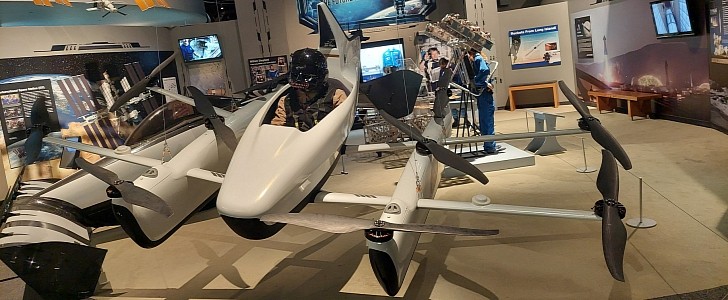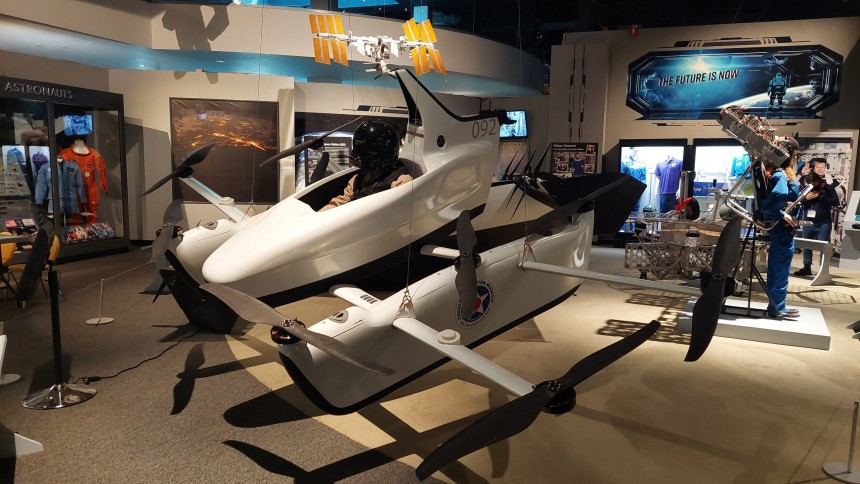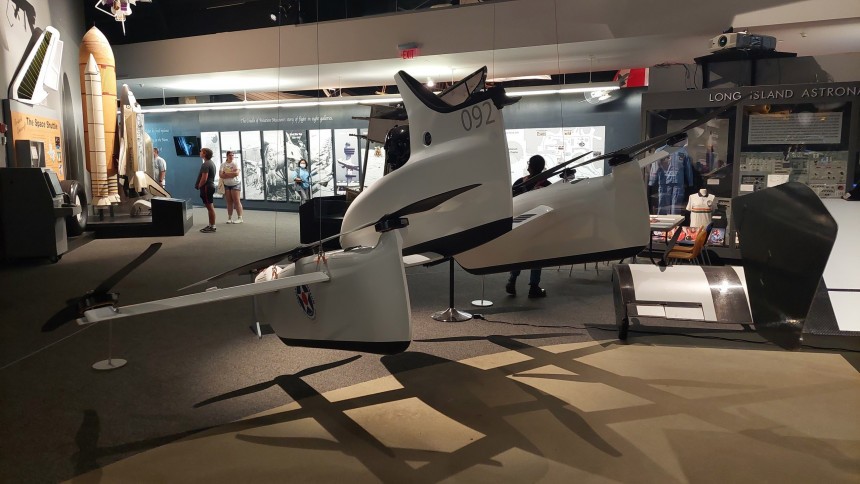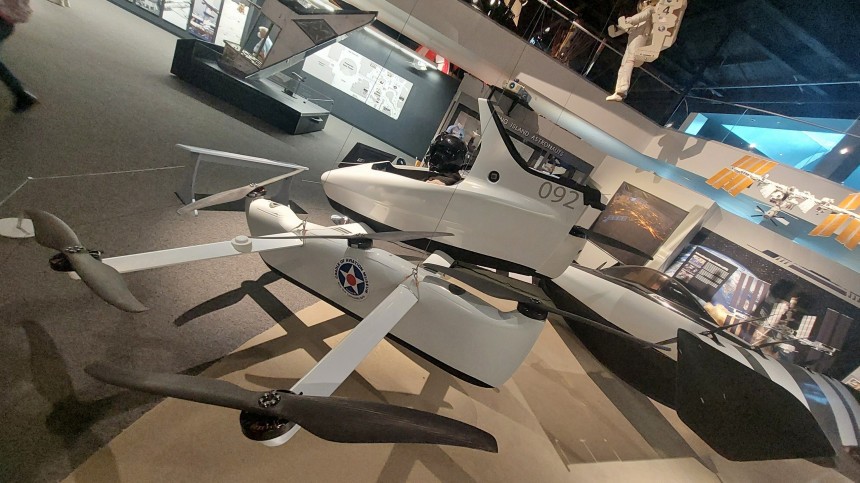What is it about celebrities and tech billionaires trying to prove they're the reincarnation of both of the Wright Brothers? You had Elon Musk, a .com billionaire that decided he wanted to build rocket ships, followed promptly by Jeff Bezos. Also, John Travolta bought a Boeing 707 and pretended to be a Pan Am pilot or something for a little while.
But not every attempt by the global jet-set to make it big in the aerospace sector is bound to be a smash hit. Just ask a former Google executive. The Kitty Hawk Flyer, for example, is an awesome-looking piece of kit on first impression. But do you really ever envision yourself flying one?
Evidently, global investors didn't. But let's take a look at the ins and outs before we decide. Firstly, a shoutout to the Cradle of Aviation Museum in Garden City, New York. Where right now, you can take an up-close look at the Kitty Hawk Flyer and a whole host of other personal mobility designs.
Out of all the exhibits on display here, which includes a jet pack consisting of dozens of tiny jet engines that strap to your shoulders, the Kitty Hawk Flyer, on the surface, appears to be the most viable option in terms of everyday useability. That's at least as far as practicality is concerned.
The Kitty Hawk Corporation was founded in Palo Alto, California, in 2010. Considering Palo Alto is one of the spiritual homes of the American tech sector, it should be no surprise that a former Google executive is at its helm. The exec in question is Sebastian Thrun. Coincidentally, he was formerly the main driving force behind the X Development program.
For those who don't know, X Development is a semi-secret research and development facility in Google's corporate headquarters in California. He also founded Google's self-driving car initiative. So then, not exactly an unskilled man in the tech field. Unveiled in June 2018 and with over 100 examples built by production's end in 2020, the Kitty Hawk Flyer was by no means a one-and-done concept.
As far as non-hydrocarbon fuels and construction materials go, the Kitty Hawk ticks all the boxes. Ten DC electric motors with a matching two-blade propeller for each replaces what would traditionally be the job of an internal combustion engine. Where plastic derived from refined petrochemicals would normally be present, KHF's body panels used epoxy bonded carbon fiber instead.
With the ability to take off vertically from land and like a traditional aircraft from the water, the Kitty Hawk Flyer had the potential to accommodate the needs of multiple market segments. At least, in theory, that is. In practice, a range in the 20-mile area and a top speed of just 35 mph (56.3kph) meant any service this vehicle would have seen would've assuredly been for short rental puddle jump-type operations with charging areas at either end of the route.
Because the FAA classifies the Kitty Hawk Flyer as an ultralight vehicle, it requires no pilot's license to operate. Though it had aspirations of true mass production, the Kitty Hawk Flyer was more of a medium-output technological demonstrator than a full-scale production vehicle, at least in practice.
Not to say the company didn't endeavor to see if a more lucrative business offer could be possible. But as was the case with so many failed tech startup's first projects, Kitty Hawk's Flyer wound up being more of a drain than advantageous. Over 25,000 flight hours were logged in 111 different Kitty Hawk Flyers examples before it wrapped up for good in June 2020.
Even with this experience under its belt, downsides like poor range, top speed, or viable maintenance infrastructure meant big-name investors never made much of a nibble. That same month, Sebastian Thrun himself announced the end of the Kitty Hawk Flyer program. From there, the company would focus on more traditional enclosed-cockpit ultralight EV aircraft designs with similar battery-electric drivetrains to those on display here at the Cradle of Aviation.
Though the Kitty Hawk Flyer itself may have been a technological dead end, you can't help but see the logic behind the idea when you see one up in the flesh. With its single-person open cockpit, you can't help but think that even if it's a short trip, you'll fondly remember the experience of flying in an aircraft like the KHF.
That's Assuming you had the intestinal fortitude to hop in the cockpit. But in the real world, where companies need to earn a profit to survive, one can only assume a really neat gimmick wasn't quite enough to cut it.
Check back soon for more from our trip to the Cradle of Aviation Museum here on autoevolution.
Evidently, global investors didn't. But let's take a look at the ins and outs before we decide. Firstly, a shoutout to the Cradle of Aviation Museum in Garden City, New York. Where right now, you can take an up-close look at the Kitty Hawk Flyer and a whole host of other personal mobility designs.
Out of all the exhibits on display here, which includes a jet pack consisting of dozens of tiny jet engines that strap to your shoulders, the Kitty Hawk Flyer, on the surface, appears to be the most viable option in terms of everyday useability. That's at least as far as practicality is concerned.
The Kitty Hawk Corporation was founded in Palo Alto, California, in 2010. Considering Palo Alto is one of the spiritual homes of the American tech sector, it should be no surprise that a former Google executive is at its helm. The exec in question is Sebastian Thrun. Coincidentally, he was formerly the main driving force behind the X Development program.
As far as non-hydrocarbon fuels and construction materials go, the Kitty Hawk ticks all the boxes. Ten DC electric motors with a matching two-blade propeller for each replaces what would traditionally be the job of an internal combustion engine. Where plastic derived from refined petrochemicals would normally be present, KHF's body panels used epoxy bonded carbon fiber instead.
With the ability to take off vertically from land and like a traditional aircraft from the water, the Kitty Hawk Flyer had the potential to accommodate the needs of multiple market segments. At least, in theory, that is. In practice, a range in the 20-mile area and a top speed of just 35 mph (56.3kph) meant any service this vehicle would have seen would've assuredly been for short rental puddle jump-type operations with charging areas at either end of the route.
Because the FAA classifies the Kitty Hawk Flyer as an ultralight vehicle, it requires no pilot's license to operate. Though it had aspirations of true mass production, the Kitty Hawk Flyer was more of a medium-output technological demonstrator than a full-scale production vehicle, at least in practice.
Even with this experience under its belt, downsides like poor range, top speed, or viable maintenance infrastructure meant big-name investors never made much of a nibble. That same month, Sebastian Thrun himself announced the end of the Kitty Hawk Flyer program. From there, the company would focus on more traditional enclosed-cockpit ultralight EV aircraft designs with similar battery-electric drivetrains to those on display here at the Cradle of Aviation.
Though the Kitty Hawk Flyer itself may have been a technological dead end, you can't help but see the logic behind the idea when you see one up in the flesh. With its single-person open cockpit, you can't help but think that even if it's a short trip, you'll fondly remember the experience of flying in an aircraft like the KHF.
That's Assuming you had the intestinal fortitude to hop in the cockpit. But in the real world, where companies need to earn a profit to survive, one can only assume a really neat gimmick wasn't quite enough to cut it.











